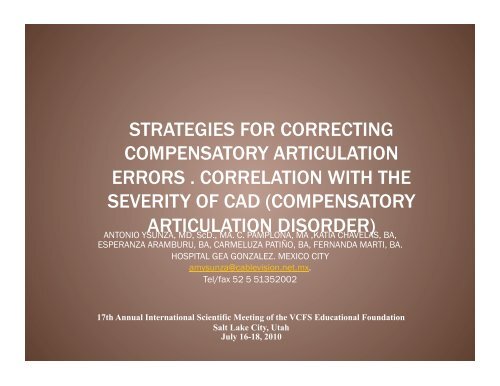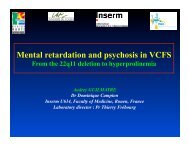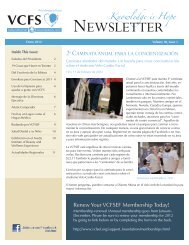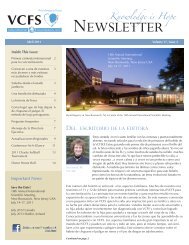The use of strategies for treating compensatory articulation errors in ...
The use of strategies for treating compensatory articulation errors in ...
The use of strategies for treating compensatory articulation errors in ...
Create successful ePaper yourself
Turn your PDF publications into a flip-book with our unique Google optimized e-Paper software.
SCALE FOR THE SEVERITY OF CAD• APROPRIATE ARTICULATION. Patient is ableto produce adequate placement and manner<strong>of</strong> <strong>articulation</strong> dur<strong>in</strong>g spontaneous speech,<strong>in</strong>clud<strong>in</strong>g non-present situations.
SCALE FOR THE SEVERITY OF CAD• INCONSTANT. <strong>The</strong> patient shows<strong>compensatory</strong> <strong>articulation</strong> <strong>errors</strong><strong>in</strong>constantly dur<strong>in</strong>g spontaneous speech.Intelligibility is not significantly affected
SCALE FOR THE SEVERITY OF CAD• ARTICULATION WITHIN CONTEXT. <strong>The</strong> patientself-corrects when us<strong>in</strong>g speech with<strong>in</strong> aspecific context. For example dur<strong>in</strong>g tell<strong>in</strong>g astory from a story book which the patientalready knows well. Nonetheless he showsfrequent <strong>compensatory</strong> <strong>errors</strong> dur<strong>in</strong>gspontaneous speech.
SCALE FOR THE SEVERITY OF CAD• ARTICULATION OF ISOLATED PHONEMES.<strong>The</strong> patient is able to correct <strong>articulation</strong>only with isolated phonemes through direct<strong>in</strong>struction
SCALE FOR THE SEVERITY OF CAD• CONSTANT CAD. <strong>The</strong> patient is not able tocorrect <strong>articulation</strong> not even <strong>in</strong> isolatedphonemes and despite direct <strong>in</strong>struction
STRATEGIES (DIRECT INSTRUCTION)• phonetic changes• th<strong>in</strong>k aloud <strong>in</strong> phonemic awareness• cloze procedure with phonemic cues
STRATEGIES (INDIRECT)• Model<strong>in</strong>g• Model<strong>in</strong>g with Stress
MODELING• <strong>The</strong> adult models the language.• Behavior is modeled bur do not normallyrequest an imitation.• It seems preferable, s<strong>in</strong>ce it is more similarto normal language learn<strong>in</strong>g than elicitedimitation.
MODELING WITH STRESS• Model the targeted sounds <strong>of</strong> speech but<strong>in</strong>cludes a light pa<strong>use</strong> be<strong>for</strong>e the sound anda stress on the phonemes the cl<strong>in</strong>icianwants to model.• Child: “cut the cake” ; <strong>The</strong> adult says: “yes,__please, __cut the __cake and give me a__piece.
CLOZE PROCEDURE WITHPHONEMIC CUES• Cl<strong>in</strong>ician prompts the child’s communicativeturn by supply<strong>in</strong>g part <strong>of</strong> the utterance andlett<strong>in</strong>g the child fill <strong>in</strong> the rest. If necessary,the cl<strong>in</strong>ician can provide the <strong>in</strong>itial sound <strong>of</strong>the target word.• “Yes, she was hungry, and she foundthree-------(bowls) <strong>of</strong> -------(soup) on the----------(table)
PHONETIC CHANGES• Indicate that the message would be moreeasily <strong>in</strong>terpreted with a modification <strong>in</strong>speech production.• “the pen”…remember to put your lipstogether and make an explosion—ppppen”• <strong>The</strong> <strong>in</strong><strong>for</strong>mation would directly contribute toref<strong>in</strong><strong>in</strong>g the phonemic dist<strong>in</strong>ction be<strong>in</strong>gmisarticulated.
THINK ALOUD IN PHONEMICAWARENESS• Th<strong>in</strong>k aloud is a metacognitive strategywhere the cl<strong>in</strong>ician verbalizes thoughts whileread<strong>in</strong>g a selection, thus model<strong>in</strong>g theprocess <strong>of</strong> comprehension.• Enables to demonstrate <strong>for</strong> the patient howto select an appropriate <strong>articulation</strong> processat a specific po<strong>in</strong>t <strong>in</strong> a particularcommunicative message.
THINK ALOUD IN PHONEMICAWARENESS• <strong>The</strong> cl<strong>in</strong>ician verbalizes specific th<strong>in</strong>k-aloud aboutdifferent levels <strong>of</strong> language organization, <strong>in</strong>clud<strong>in</strong>gphonologic <strong>in</strong><strong>for</strong>mation.• Be<strong>for</strong>e look<strong>in</strong>g at a story book: “th<strong>in</strong>k which sounds wewill be focus<strong>in</strong>g on. We have to consider that thesesounds are short and explosive (/k/, /p/, /t/). We willwrite the letters <strong>for</strong> rem<strong>in</strong>d<strong>in</strong>g you to <strong>use</strong> your bestspeech. Besides, we have other sounds that are long andcont<strong>in</strong>uous, like /s/ (write <strong>in</strong> another paper).While look<strong>in</strong>gat the story book, the cl<strong>in</strong>ician is focus<strong>in</strong>g on the targetsounds and expla<strong>in</strong><strong>in</strong>g the characteristics <strong>of</strong> eachphoneme and how chang<strong>in</strong>g the sounds can modify thecharacteristics <strong>of</strong> the word <strong>in</strong>creas<strong>in</strong>g <strong>in</strong>telligibility .
RESULTS• <strong>The</strong>re was a significant relationship betweenthe success <strong>of</strong> all <strong>strategies</strong> and the degree<strong>of</strong> severity <strong>of</strong> CAD <strong>in</strong> VCFS patients
RESULTS• Strategies which <strong>in</strong>volve direct <strong>in</strong>struction on<strong>articulation</strong> appear to be more effective <strong>in</strong>more severe levels <strong>of</strong> CAD.
RESULTS• Strategies which do not <strong>in</strong>volve direct<strong>in</strong>struction are equally effective <strong>in</strong> milderlevels <strong>of</strong> CAD.
CONCLUSIONS• STRATEGIES WHICH DO NOT INVOLVEDIRECT INSTRUCTION ON ARTICULATION AREEQUALLY EFFECTIVE IN MILDER LEVELS OFCOMPENSATORY ARTICULATION DISORDER
CONCLUSIONS• When speech <strong>in</strong>tervention <strong>for</strong> a VCFS patientwith CAD is be<strong>in</strong>g planned, it is essential toassess the severity <strong>of</strong> the CAD. Furthermore,some <strong>strategies</strong> should be selectedaccord<strong>in</strong>g to the level <strong>of</strong> severity <strong>of</strong> thisdisorder.













